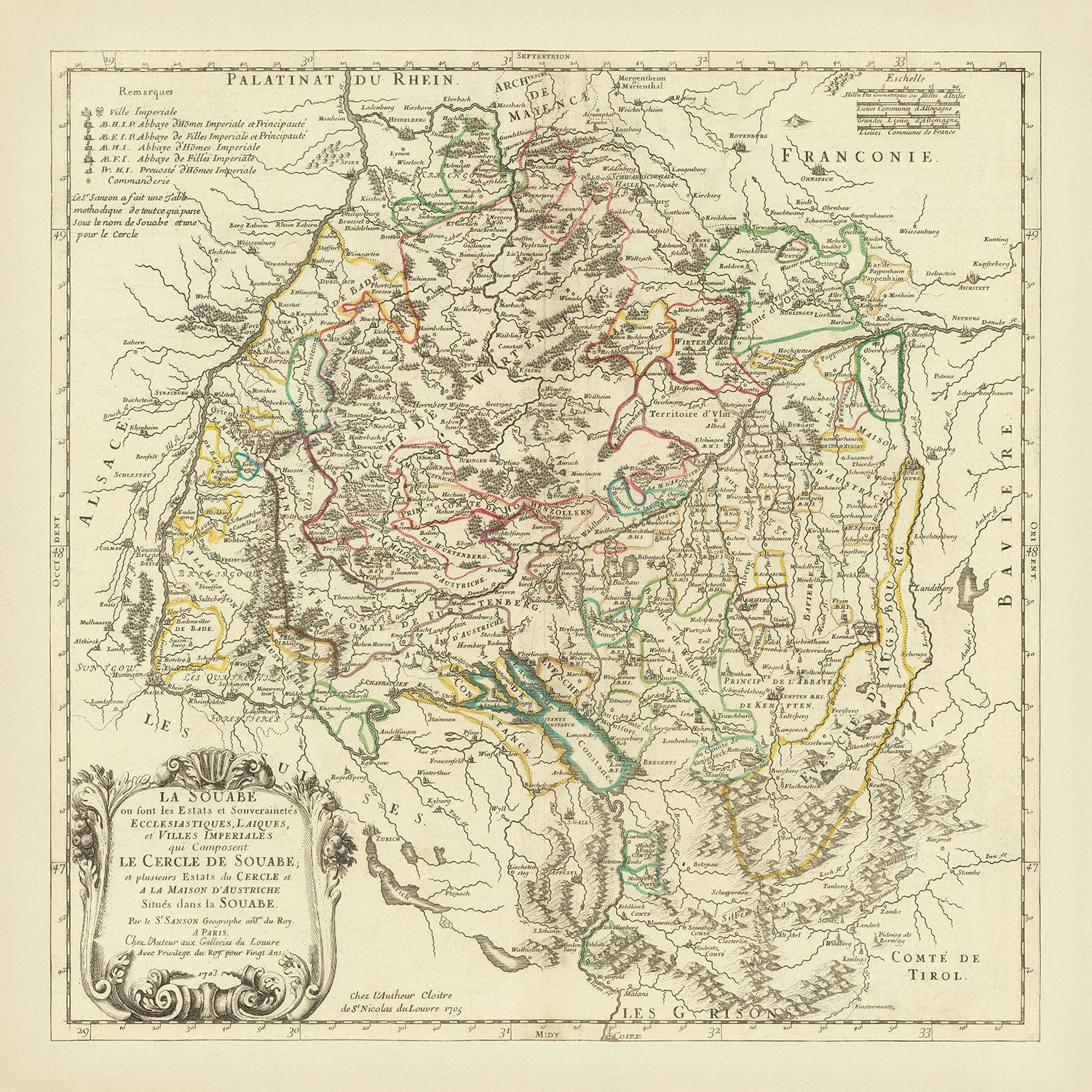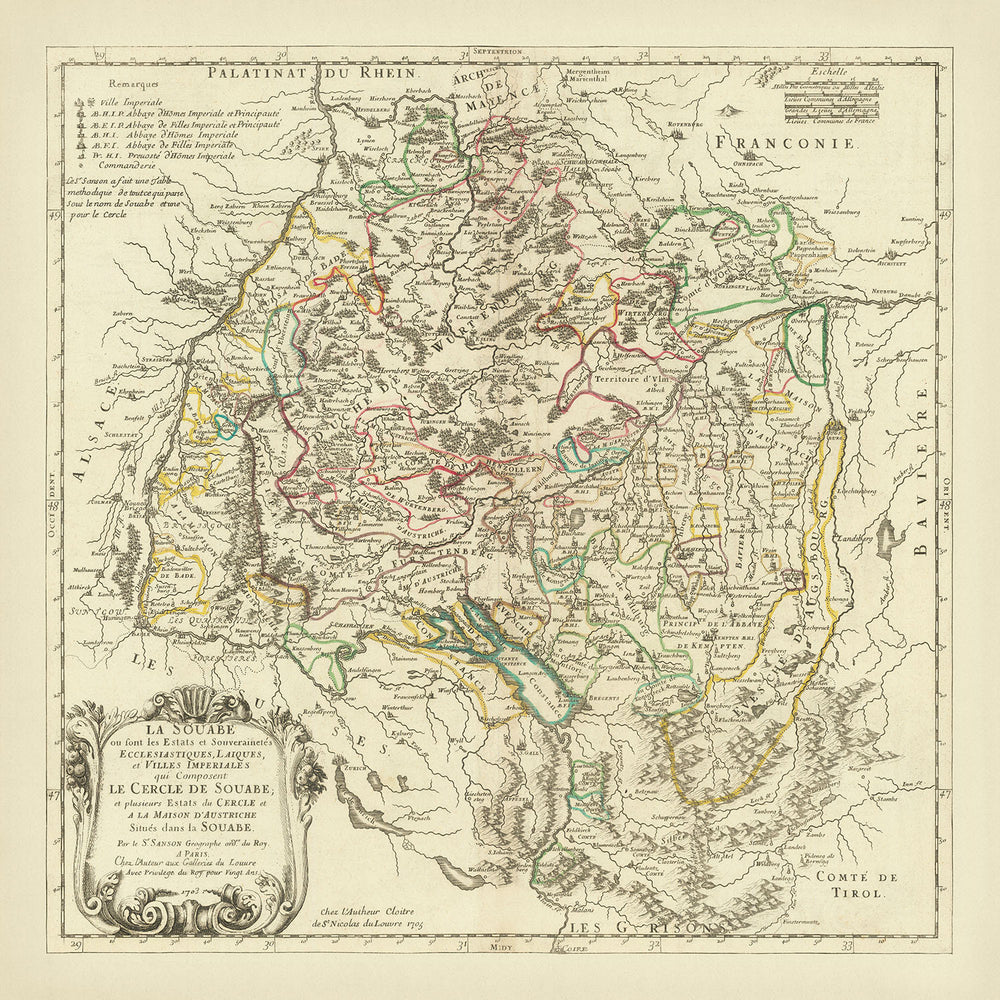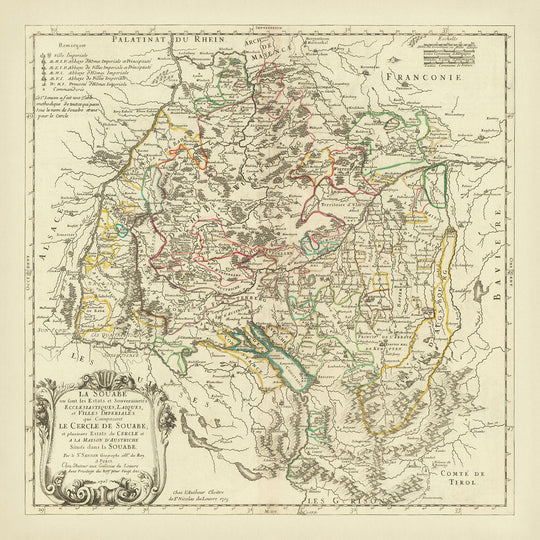- Handmade locally. No import duty or tax
- FREE Delivery by Christmas
- Love it or your money back (90 days)
- Questions? WhatsApp me any time
Own a piece of history
5,000+ 5 star reviews


La Souabe ou sont les Estats et Souverainetes Ecclesiastiques, Laiques, et Viles Imperiales qui Composent Le Cercle De Souabe, created by the esteemed French cartographer Nicolas Sanson in 1703, is a masterful depiction of the Swabia province in southern Germany. This antique map, originally published in the mid-17th century, is a testament to Sanson's unparalleled skill in combining detailed geographical information with an aesthetic simplicity that remains timeless. The map meticulously charts the intricate political and physical landscape of Swabia, showcasing forests, towns, cities, and roads with an elegance that is characteristic of the French School of cartography.
Nicolas Sanson, often hailed as the "father of French cartography," revolutionized mapmaking in France during the 17th century. His dedication to accuracy and detail is evident in this map, which not only serves as a geographical guide but also as a historical document. Sanson's work was instrumental in the development of cartography, and his maps were highly regarded for their precision and clarity. This map of Swabia is a prime example of his expertise, capturing the region's complexity with remarkable finesse.
The map's design is both informative and visually appealing, featuring a decorative cartouche in the lower left corner and a scale bar in the upper right. The legend provides insight into the different types of towns and cities, including Imperial Cities and military "comanderies," adding depth to the viewer's understanding of the region's political structure. The careful delineation of borders, states, and territories within Swabia reflects the intricate nature of the Holy Roman Empire's political landscape during this period.
Swabia, as depicted in this map, is a region rich in natural and historical landmarks. The map highlights significant cities such as Basel, Stuttgart, Augsburg, and Heidelberg, each with its unique historical and cultural heritage. The representation of the Black Forest (Schwarzwald) and the Rhine River, along with other rivers and mountain ranges, adds to the map's geographical richness. Lakes, including Lake Constance (Bodensee), and various wooded areas are also prominently marked, showcasing the natural beauty of the region.
This map is not just a tool for navigation but a window into the past, offering a glimpse into the historical context of early 18th-century Swabia. It reflects the complex political divisions and the rich tapestry of towns, roads, and natural features that defined the region. For collectors and enthusiasts of historical cartography, this map is a valuable piece that combines artistic beauty with historical significance, capturing the essence of Swabia as it was over three centuries ago.
Cities and towns on this map
- Stuttgart (modern-day population: ~630,000)
- Heidelberg (modern-day population: ~160,000)
- Augsburg (modern-day population: ~300,000)
- Ulm (modern-day population: ~125,000)
- Konstanz (modern-day population: ~85,000)
- Reutlingen (modern-day population: ~115,000)
- Tübingen (modern-day population: ~90,000)
- Freiburg (modern-day population: ~230,000)
- Esslingen (modern-day population: ~95,000)
- Basel (modern-day population: ~200,000)
- Strasbourg (modern-day population: ~280,000)
Notable Features & Landmarks
- Forests and wooded areas are prominently marked.
- Numerous rivers and streams, including the Rhine River.
- Mountain ranges and hilly regions.
- Decorative cartouche in the lower left corner.
- Scale bar in the upper right corner.
- Legend explaining different types of towns and cities.
- Borders of various states and territories within Swabia.
- Roads and routes connecting different towns and cities.
- Lakes and bodies of water, including Lake Constance (Bodensee).
- Ecclesiastical territories and regions.
- Imperial territories and free cities.
- Military "comanderies" and fortifications.
- Detailed topographical features.
- Symbols indicating different types of settlements.
- Names and boundaries of various historical regions and states.
- Representation of the Black Forest (Schwarzwald).
- Surrounding regions such as Alsace, Bavaria, and Tyrol.
- Indication of significant historical regions like Franconia and the Palatinate.
Historical and design context
- Original antique map of the province Swabia, in southern Germany, published by Nicolas Sanson in Paris.
- This is a 1703 state of the map which was originally published in the mid-17th century.
- The map is highly detailed in Sanson's French School style, containing large amounts of information but remaining simple and aesthetic in its decorative tendencies.
- The map follows the French School style of cartography, which emphasizes clarity, detail, and aesthetic appeal.
- Nicolas Sanson was a prominent French cartographer known as the "father of French cartography." He played a significant role in the development of mapmaking in France during the 17th century.
- The map provides a detailed view of the political and physical landscape of Swabia in the early 18th century.
- It reflects the complex political structure of the Holy Roman Empire, with its numerous small states and territories.
Please double check the images to make sure that a specific town or place is shown on this map. You can also get in touch and ask us to check the map for you.
This map looks great at every size, but I always recommend going for a larger size if you have space. That way you can easily make out all of the details.
This map looks amazing at sizes all the way up to 70in (180cm). If you are looking for a larger map, please get in touch.
The model in the listing images is holding the 16x16in (40x40cm) version of this map.
The fifth listing image shows an example of my map personalisation service.
If you’re looking for something slightly different, check out my collection of the best old maps to see if something else catches your eye.
Please contact me to check if a certain location, landmark or feature is shown on this map.
This would make a wonderful birthday, Christmas, Father's Day, work leaving, anniversary or housewarming gift for someone from the areas covered by this map.
This map is available as a giclée print on acid free archival matte paper, or you can buy it framed. The frame is a nice, simple black frame that suits most aesthetics. Please get in touch if you'd like a different frame colour or material. My frames are glazed with super-clear museum-grade acrylic (perspex/acrylite), which is significantly less reflective than glass, safer, and will always arrive in perfect condition.
This map is also available as a float framed canvas, sometimes known as a shadow gap framed canvas or canvas floater. The map is printed on artist's cotton canvas and then stretched over a handmade box frame. We then "float" the canvas inside a wooden frame, which is available in a range of colours (black, dark brown, oak, antique gold and white). This is a wonderful way to present a map without glazing in front. See some examples of float framed canvas maps and explore the differences between my different finishes.
For something truly unique, this map is also available in "Unique 3D", our trademarked process that dramatically transforms the map so that it has a wonderful sense of depth. We combine the original map with detailed topography and elevation data, so that mountains and the terrain really "pop". For more info and examples of 3D maps, check my Unique 3D page.
For most orders, delivery time is about 3 working days. Personalised and customised products take longer, as I have to do the personalisation and send it to you for approval, which usually takes 1 or 2 days.
Please note that very large framed orders usually take longer to make and deliver.
If you need your order to arrive by a certain date, please contact me before you order so that we can find the best way of making sure you get your order in time.
I print and frame maps and artwork in 23 countries around the world. This means your order will be made locally, which cuts down on delivery time and ensures that it won't be damaged during delivery. You'll never pay customs or import duty, and we'll put less CO2 into the air.
All of my maps and art prints are well packaged and sent in a rugged tube if unframed, or surrounded by foam if framed.
I try to send out all orders within 1 or 2 days of receiving your order, though some products (like face masks, mugs and tote bags) can take longer to make.
If you select Express Delivery at checkout your order we will prioritise your order and send it out by 1-day courier (Fedex, DHL, UPS, Parcelforce).
Next Day delivery is also available in some countries (US, UK, Singapore, UAE) but please try to order early in the day so that we can get it sent out on time.
My standard frame is a gallery style black ash hardwood frame. It is simple and quite modern looking. My standard frame is around 20mm (0.8in) wide.
I use super-clear acrylic (perspex/acrylite) for the frame glass. It's lighter and safer than glass - and it looks better, as the reflectivity is lower.
Six standard frame colours are available for free (black, dark brown, dark grey, oak, white and antique gold). Custom framing and mounting/matting is available if you're looking for something else.
Most maps, art and illustrations are also available as a framed canvas. We use matte (not shiny) cotton canvas, stretch it over a sustainably sourced box wood frame, and then 'float' the piece within a wood frame. The end result is quite beautiful, and there's no glazing to get in the way.
All frames are provided "ready to hang", with either a string or brackets on the back. Very large frames will have heavy duty hanging plates and/or a mounting baton. If you have any questions, please get in touch.
See some examples of my framed maps and framed canvas maps.
Alternatively, I can also supply old maps and artwork on canvas, foam board, cotton rag and other materials.
If you want to frame your map or artwork yourself, please read my size guide first.
My maps are extremely high quality reproductions of original maps.
I source original, rare maps from libraries, auction houses and private collections around the world, restore them at my London workshop, and then use specialist giclée inks and printers to create beautiful maps that look even better than the original.
My maps are printed on acid-free archival matte (not glossy) paper that feels very high quality and almost like card. In technical terms the paper weight/thickness is 10mil/200gsm. It's perfect for framing.
I print with Epson ultrachrome giclée UV fade resistant pigment inks - some of the best inks you can find.
I can also make maps on canvas, cotton rag and other exotic materials.
Learn more about The Unique Maps Co.
Map personalisation
If you're looking for the perfect anniversary or housewarming gift, I can personalise your map to make it truly unique. For example, I can add a short message, or highlight an important location, or add your family's coat of arms.
The options are almost infinite. Please see my map personalisation page for some wonderful examples of what's possible.
To order a personalised map, select "personalise your map" before adding it to your basket.
Get in touch if you're looking for more complex customisations and personalisations.
Map ageing
I have been asked hundreds of times over the years by customers if they could buy a map that looks even older.
Well, now you can, by selecting Aged before you add a map to your basket.
All the product photos you see on this page show the map in its Original form. This is what the map looks like today.
If you select Aged, I will age your map by hand, using a special and unique process developed through years of studying old maps, talking to researchers to understand the chemistry of aging paper, and of course... lots of practice!
If you're unsure, stick to the Original colour of the map. If you want something a bit darker and older looking, go for Aged.
If you are not happy with your order for any reason, contact me and I'll get it fixed ASAP, free of charge. Please see my returns and refund policy for more information.
I am very confident you will like your restored map or art print. I have been doing this since 1984. I'm a 5-star Etsy seller. I have sold tens of thousands of maps and art prints and have over 5,000 real 5-star reviews. My work has been featured in interior design magazines, on the BBC, and on the walls of dozens of 5-star hotels.
I use a unique process to restore maps and artwork that is massively time consuming and labour intensive. Hunting down the original maps and illustrations can take months. I use state of the art and eye-wateringly expensive technology to scan and restore them. As a result, I guarantee my maps and art prints are a cut above the rest. I stand by my products and will always make sure you're 100% happy with what you receive.
Almost all of my maps and art prints look amazing at large sizes (200cm, 6.5ft+) and I can frame and deliver them to you as well, via special oversized courier. Contact me to discuss your specific needs.
Or try searching for something!
















































